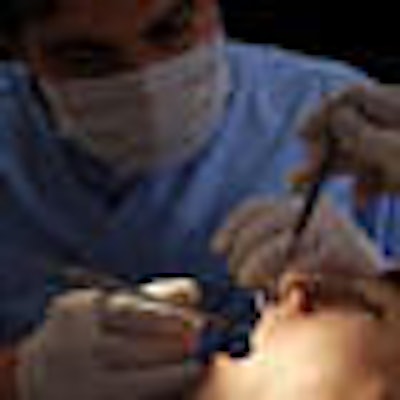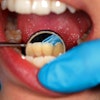
The approach contradicts what most dentists learned in dental school. And it can add another step to the process of placing an indirect restoration. But a growing chorus of researchers, taking their lead from Pascal Magne, D.M.D., Ph.D., says it's well worthwhile to seal dentin before placing a temporary.
The notion goes back at least to 1992 when David Pashley, D.M.D., Ph.D., a Medical College of Georgia professor, proposed sealing dentin immediately after preparation for a crown.
Now evidence is mounting for immediate dentin sealing (IDS), not only for crowns but also for inlays, onlays, and veneers. At least one adhesive company -- Bisco -- has taken the approach into consideration in designing its latest products. And IDS is being debated at widely attended symposia on restoration techniques, including the 2008 ADA meeting in San Antonio.
"I meet people all the time who are enthusiasts," Dr. Magne told DrBicuspid.com. Dr. Magne, a University of Southern California associate professor, has extensively researched the method and become its leading proponent. "It seems like it's obvious that it's a useful procedure. There's nothing to lose."
But at the recent ADA meeting, Jeff Brucia, D.D.S., co-director of the Foundation for Advanced Continuing Education (FACE), suggested that a careful variation of the conventional technique might be more practical than IDS.
In his latest paper (Journal of Prosthetic Dentistry, September 2007, Vol. 98:3, pp. 166-174), Dr. Magne and his colleagues prepared 30 extracted human molars and immediately bonded their dentin: 15 with OptiBond FL (Kerr Dental) and 15 with SE Bond (Kuraray). They then restored the teeth with Tempfil Inlays (Kerr) and soaked them in saline solution for 2, 7, or 12 weeks before removing the temporaries, cleaning and sandblasting them, and applying more adhesive to restore them with Z100 (3M ESPE).
For comparison purposes, they placed Tempfil Inlays on 10 molars without bonding the dentin first, and soaked these in saline solution for two weeks before using either OptiBond FL or SE Bond to attach the Z100.
They found that the microtensile bond strength of the permanent restorations on the IDS teeth was between 5 and 33 times stronger than it was on the conventionally restored teeth.
One reason IDS is stronger is that dentin bonds best to composite when the dentin is freshly cut, Dr. Magne said. Provisional cement, saliva, and bacteria can all contaminate the dentin and weaken the seal.
Also, curing the adhesive before placing the restoration may result in a stronger bond because the cured adhesive keeps collagen fibers from collapsing under pressure when the restoration is put in place.
Another reason the bond may be stronger is that the copolymerization continues for several days before it takes on an occlusal load.
IDS also results in less sensitivity when the temporary is removed and the permanent restoration placed; in fact, with IDS no anesthesia is required during this step (unless needed for the rubber dam), Dr. Magne said.
Finally, if you seal the dentin before making the impression, the impression includes the contours of the adhesive.
He lays out complete instructions for his approach in the Journal of Esthetic and Restorative Dentistry (May 2005, Vol. 17:3, pp. 144-155).
The technique is becoming so popular that Bisco's instructions for All-Bond 3 -- released in February 2007 -- explain how to use it prior to impression making for crowns. In addition, the company is planning to launch a new product, Pro-V Coat, which can be used to keep temporaries from bonding to the adhesive used in IDS.
(Dr. Magne uses OptiBond FL as the adhesive and applies a layer of glycerin jelly to isolate the temporary.)
Speaking at an ADA seminar on new restorative techniques, Dr. Brucia agreed that it's important to seal the dentin right after preparing it. He said he'd tested the IDS technique described by Dr. Magne and found it "excellent."
But he also noted that many dentists are likely to make mistakes in applying it. For example, he argued that it's difficult to bond to the cured adhesive unless the surface is roughened by proper sandblasting. He thinks many dentists will omit this step or will use aluminum oxide instead of CoJet (3M ESPE). Or, he said, many dentists will use unfilled adhesive, which isn't thick enough to stand up to such sandblasting.
Because of the difficulty of the technique, Dr. Brucia, "It's not accepted within the dental industry."
So he proposed an alternative. "Pascal will tell you that the only time you can get excellent bond strength to dentin is the day that you prepped it," Dr. Brucia said. "That's not exactly true. If you can keep that tooth clean and refreshen the dentin at cementation, you will be able to produce that exact bond."
The key, he argued, is to find a cement that bonds to the tooth rather than to the temporary restoration. This will seal the tooth until it's time to place the permanent restoration. Dr. Brucia uses Durelon (3M ESPE). He removes it with an ultrasonic scaler, a process he said takes him only about 20 seconds.
"I disagree, of course," said Dr. Magne, when asked about this approach. "It would be a dream if the cement would do everything. But you will not get the effect of desensitizing the tooth once and for all."
Dr. Magne usually doesn't need to anesthetize his patients for try-in procedures or when placing the permanent restoration, while Dr. Brucia does.
Dr. Magne also argued that curing the adhesive just before placing the permanent restoration results in a layer that changes the contours of the surface being restored. And leaving the adhesive uncured when placing the final restoration results in a weaker bond.
In the end, though, both experts agree on one important principle: seal your dentin when you place the temporary.















